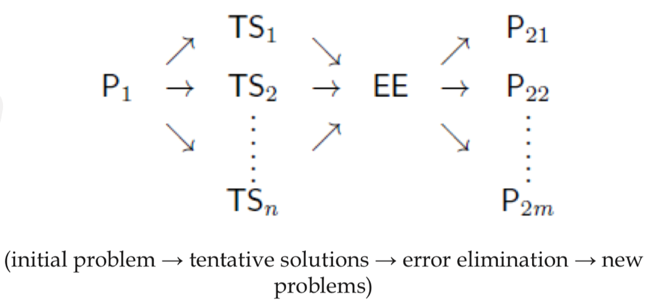recent
In Celebration of Errors
Shouting someone down for speaking a thought in public effectively ends the critical discussion. There can be no further exploration of why the idea at issue is wrong, or what kernel of truth there may be therein.

Making mistakes is out of fashion. To utter the wrong phrase or entertain an uncomfortable hypothesis is to risk both personal and professional ostracism. You might express an idea that is false, such as that the Earth is flat. Or you might say something that is true but nonetheless violates some taboo. A historical example is the assertion that the Earth revolves around the Sun, which once upon a time would have landed a person in hot water with the Catholic Church, as scientist Galileo Galilei learned the hard way in the 1600s. The content of what is unspeakable ebbs and flows over time as culture evolves and our understanding of reality improves. While defending Darwin’s theory of evolution by natural selection would once have elicited mockery, today, the opposite is (mostly) true.
It is irrelevant whether or not someone is correct when he initially expresses an idea. What matters is how others respond to an idea that they find unpalatable, as solving problems always requires correcting errors. Civilization has been in the game of solving problems for thousands of years. Out of the Hobbesian nightmare of the African savannah, humanity has been making progress in virtually every conceivable arena. The Human Progress website is a wonderful source of information about long-term trends that defy the bloody anecdotes of mainstream news outlets. Between 2001 and 2015, for example, the worldwide infant mortality rate declined by 38 percent, and undernourishment fell by 27.5 percent. These trends are nothing short of remarkable.
And this is to say nothing of the progress we’ve been making regarding our scientific understanding of the world, which is intimately connected to the trends in prosperity—the better we understand the world, the more we can bend it to our advantage. Since the Scientific Revolution in the sixteenth and seventeenth centuries, humanity has come to understand the world in ways that would baffle our ancestors. We know about the molecule that codes for life and all of its requirements. We know how old the Universe is, and about its historical evolution. And, crucially, we’ve ascertained the process by which we may discover how reality works in the first place—the scientific method.

The man who worked out the logic of problem-solving is the twentieth century philosopher, Karl Popper. His philosophy of knowledge is technically called critical rationalism. We face reality and wish to understand it, but there’s no infallible guide “out there” with answers to our questions, so we have to guess the truth of the matter. We conjecture an explanation about some phenomenon in Nature. For example, that the Sun rises and falls every day is a regularity that people had wanted to explain for a long time. Humanity’s first guesses were what we now regard as myths—the ancient Sumerians thought that Shamash, their Sun god, awaited the eastern gates to open before traveling westward across the sky every day, only to travel through the Underworld at night so that he’d return to his original location for the next morning’s travels. Such a myth is a conjecture, or a proposed explanation.
The early heroes of science were those who found these myths wanting. That is, they felt that the myths, as explanations of the world, did not stand up to scrutiny—that they contained severe errors. They proposed what they thought were better explanations, and compared them to the myths that came before. It wasn’t enough to say that the gods did it, since such assertions can apply to anything at all. In this case, the error that Galileo and his contemporaries had discovered in mythological explanations was that they were arbitrary.
So when the titans of astronomy explained the motions of the Sun in the sky in terms of mathematical, testable laws, they set the agenda for what science was all about—finding errors in our best theories and correcting for them. Hypothesis, theory, explanation—they are all conjectured solutions to problems in our worldview. Because our explanations are conjectural, we can never be certain that they are correct, no matter how much they have stood up to scrutiny.
It is often the case that more than one hypothesis is proposed to explain the same phenomenon. We then subject all guesses to as much criticism as we can summon until there is only one hypothesis remaining. A well-known method of criticism is experimentation. When two theories yield different predictions for the outcome of a given physical process, we can test the theories against observations. A famous, if apocryphal, example is that of Galileo dropping weights from the Tower of Pisa (Galileo was a busy man). Aristotle’s theory of motion, widely accepted in Galileo’s time, predicted that heavier objects fell faster than lighter objects. Galileo didn’t think that the time it took for objects to reach the ground depended on their mass. His experiment of dropping weights from the same height was the perfect arbiter between his theory and Aristotle’s—each made a unique prediction about how long the objects would take to reach the ground relative to each other. Galileo was vindicated, and Aristotle’s theory was cast to the dustbin of history. Thus, progress was made.
The entire procedure outlined above—notice errors in our worldview, guess candidate explanations, criticize them, and tentatively accept whatever survives—applies to far more than science. As far as we know, it applies to all possible problems, scientific or otherwise. Economic, technological, and moral shortcomings are also solvable via the method of critical rationalism. This is not to say that it is ever easy. But it is always possible in principle.

Diagrammatic representation of Popper’s critical rationalism. Discover a problem/unexplained phenomena (P1), propose several potential theories/solutions (TS1, TS2, etc.), criticize all potential theories/solutions until one remains, eliminate errors/explain phenomena by applying the surviving theory/solution, discover new problems (P21, P22, etc.), repeat.
In order to solve a problem, we have to understand the relevant error as such. For example, beating children cannot end as a cultural practice until it is understood why initiating violence is wrong, why children are moral agents with individual rights. Here, correcting for the error of child-beating necessarily involves understanding a whole host of ideas, and why particular actions are wrong in light of those ideas.
Shouting someone down for speaking a thought in public effectively ends the critical discussion. There can be no further exploration of why the idea at issue is wrong, or what kernel of truth there may be therein. The forced termination of the critical discussion implies that there can be no further errors, that all problems have already been solved.
But all problems have not been solved—not in science, nor in society at large. All we can do is discover problems, guess candidate solutions, and then criticize these proposals with all of the tools in our arsenal. If people are afraid to suggest solutions for fear of backlash, we lose all of those potential paths to progress.
Errors are oddly beautiful in their own way. They are inevitable and problematic, and yet they prod us into deciding which problem to solve next. It is as if they mandate their own destruction so that we may prosper.
A toast to errors.






